语言学题库5
《语言学概论》试题库
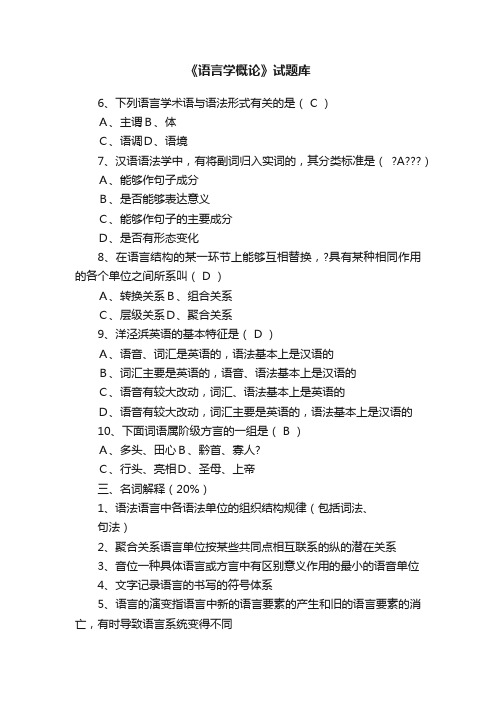
《语言学概论》试题库6、下列语言学术语与语法形式有关的是( C )A、主谓B、体C、语调D、语境7、汉语语法学中,有将副词归入实词的,其分类标准是(?A)A、能够作句子成分B、是否能够表达意义C、能够作句子的主要成分D、是否有形态变化8、在语言结构的某一环节上能够互相替换,?具有某种相同作用的各个单位之间所系叫( D )A、转换关系B、组合关系C、层级关系D、聚合关系9、洋泾浜英语的基本特征是( D )A、语音、词汇是英语的,语法基本上是汉语的B、词汇主要是英语的,语音、语法基本上是汉语的C、语音有较大改动,词汇、语法基本上是英语的D、语音有较大改动,词汇主要是英语的,语法基本上是汉语的10、下面词语属阶级方言的一组是( B )A、多头、田心B、黔首、寡人?C、行头、亮相D、圣母、上帝三、名词解释(20%)1、语法语言中各语法单位的组织结构规律(包括词法、句法)2、聚合关系语言单位按某些共同点相互联系的纵的潜在关系3、音位一种具体语言或方言中有区别意义作用的最小的语音单位4、文字记录语言的书写的符号体系5、语言的演变指语言中新的语言要素的产生和旧的语言要素的消亡,有时导致语言系统变得不同四、试以国际音标标出下列各词的读音(10%)1、年龄2、至少3、寒暄4、角度5、部门五、用义素分析法分析下列各组词( 9%)妻子 [+人 +女性 +成年 +未昏]1、{未婚妻 [+人 +女性 +成年 +已昏]香(气味香) [+嗅觉 +好气味]2、{香(他很吃香)[+感觉 +受欢迎]3、镰刀 [+工具 +农具 +用于割谷物和割草+由弧形刀片和木把构成]六、解答题(21%)1、指出汉语普通话 e音位的几个条件变体,?描述其发音特点和出现条件。
A、四个:[e]、[ε]、[?]、[γ](1分)B、发音特点(3分)[e]前、半高、不圆唇舌面元音[ε]前、半低、不圆唇舌面元音[?]央、中、不圆唇舌面元音[γ]后、半高、不圆唇舌面元音C、出现条件(3分)[e]在[i]前[ε]在[i][y]后[?]在[n][ ]前或辅音后轻声[γ]单独或辅音2、?狼孩子?的故事说明了什么?狼孩子的故事说明了:A、语言是人类社会特有的现象。
大学语言学试题
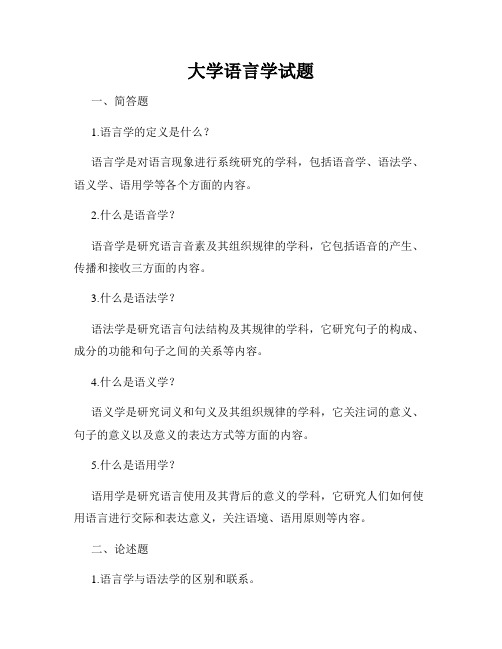
大学语言学试题一、简答题1.语言学的定义是什么?语言学是对语言现象进行系统研究的学科,包括语音学、语法学、语义学、语用学等各个方面的内容。
2.什么是语音学?语音学是研究语言音素及其组织规律的学科,它包括语音的产生、传播和接收三方面的内容。
3.什么是语法学?语法学是研究语言句法结构及其规律的学科,它研究句子的构成、成分的功能和句子之间的关系等内容。
4.什么是语义学?语义学是研究词义和句义及其组织规律的学科,它关注词的意义、句子的意义以及意义的表达方式等方面的内容。
5.什么是语用学?语用学是研究语言使用及其背后的意义的学科,它研究人们如何使用语言进行交际和表达意义,关注语境、语用原则等内容。
二、论述题1.语言学与语法学的区别和联系。
语言学是对语言现象进行全面研究的学科,涵盖了语音学、语法学、语义学和语用学等方面的内容。
而语法学是语言学的一个分支,主要研究语法现象及其规律。
语言学与语法学的联系在于语法学是语言学的重要组成部分,它提供了研究语言结构和规律的方法和理论基础。
同时,语法学的研究结果也为语言学的其他方面提供了重要的参考。
然而,语言学与语法学的区别在于语言学更加宏观和综合,它研究语言的各个方面,包括语音、词汇、句法、语义和语用等。
而语法学则是语言学中具体研究句法现象的一个分支,着重研究句子的构成、成分的功能和句子之间的关系。
2.语音学与音系学的关系。
语音学研究语音的产生、传播和接收,它是语言学的一个重要分支学科。
而音系学则是语音学中研究语言音素及其组织规律的一个分支领域。
语音学通过观察和记录语音现象,研究不同语音之间的差异和共性。
而音系学则在此基础上进一步研究语言中的音素及其分类、组织以及声音之间的相互关系。
简言之,语音学是对语音现象的整体研究,而音系学是语音学中对语音结构及其规律的具体研究。
三、分析题1.什么是语言的意义?语言的意义是指语言表达所传递的信息内容。
它涉及词汇意义、句子意义和话语意义等多个层次。
语言学题库

绪论一、填空1.语言学的三大发源地是(中国)(印度)(罗马-希腊)2.语言学是(19 )世纪成为独立的一门学科,标志是(欧洲历史比较语言学的形成)。
3.现代语言学的标志性著作是瑞士语言学家(索绪尔)的(普通语言教程)。
4.语言交际过程可以分为(编码)、(发送)、(传递)、(接收)、(解码)五个阶段。
5.(文字)、(音韵)、(训诂之学)是中国古代“小学”的主要内容。
6.印度最早的经典所使用的语言是(梵文)。
二、判断正误()1、语文学主要研究古代的口语和书面语。
()2、语言有自身结构的独立性,与系统之外的社会环境没有关系。
()3、理论语言学是研究语言一般规律的,不受具体语言研究的影响,。
()4、语言形式和内容的关系,是语言研究的根本问题。
第一章语言的功能一、填空1、语言的功能包括(社会)功能和(思维)功能。
2、语言的社会功能包括(语言交际)功能和(人际互动)功能。
3、在各种信息传递形式中,(语言)是第一性的、最基本的手段。
4、人的大脑分左右两个半球,语言功能及计数、推理能力等由(左)半球掌管,音乐感知、立体图形识别等能力由(右)半球制约。
5、儿童语言习得一般经过(独词句)阶段和(双词句)阶段,这是儿童学话的关键两步。
二、判断正误()1、文字是建立在语言基础之上的再编码形式。
()2、当说话者陈述一个客观事实时,话语中不具有主观性。
()3、书刊上的话语不具有人际互动功能。
()4、抽象思维要以语言为形式依托。
()5、布洛卡区在大脑的右半球前部。
()6、聋哑人不会说话,所以不具有抽象思维的能力。
()7、不同语言结构的差异体现出思维方式的不同。
()8、汉语名词没有数的变化,所以汉语没有区别单数和多数的概念。
()9.语言有阶级性。
()10.语言是全民交际工具,所以语言的使用全民没有差别。
()11.身势、表情等能够代替语言所以能够脱离语言。
三.思考题1、为什么说语言是人类最重要的信息传递的手段?除了语言之外,人们还使用其他的信息传递工具:(1)文字、旗语、红绿灯、电报代码、数学符号、化学公式等辅助性的交际工具(2)体态语等伴随性的副语言交际工具,(3)盲文、手语等类语言交际工具。
语言学考试题库及答案
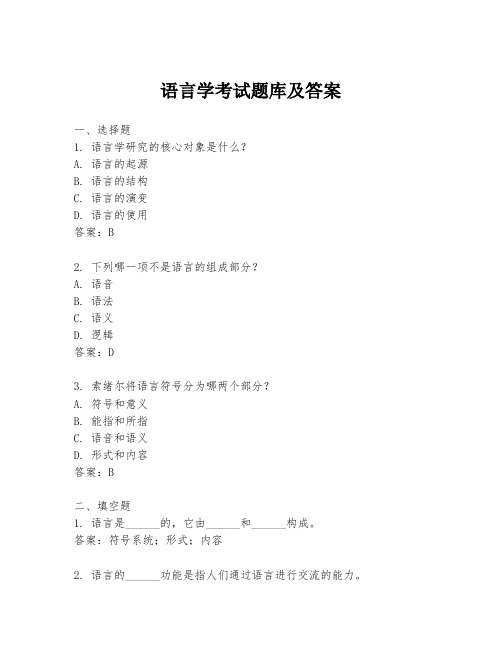
语言学考试题库及答案一、选择题1. 语言学研究的核心对象是什么?A. 语言的起源B. 语言的结构C. 语言的演变D. 语言的使用答案:B2. 下列哪一项不是语言的组成部分?A. 语音B. 语法C. 语义D. 逻辑答案:D3. 索绪尔将语言符号分为哪两个部分?A. 符号和意义B. 能指和所指C. 语音和语义D. 形式和内容答案:B二、填空题1. 语言是______的,它由______和______构成。
答案:符号系统;形式;内容2. 语言的______功能是指人们通过语言进行交流的能力。
答案:交流3. 语言的______功能是指语言能够表达思想和情感的能力。
答案:表达三、简答题1. 简述语言和言语的区别。
答案:语言是指一种抽象的符号系统,它包括语音、语法、语义等规则和结构;言语则是指个人使用语言进行交流的具体行为。
2. 描述索绪尔的“能指”和“所指”概念。
答案:索绪尔认为语言符号由“能指”和“所指”两部分组成。
“能指”指的是语言符号的声音形式,而“所指”指的是符号所代表的概念或意义。
四、论述题1. 论述语言的任意性原则及其对语言学习和教学的影响。
答案:语言的任意性原则指的是语言符号的声音形式和它所代表的概念之间没有必然的联系。
这一原则对语言学习和教学有着深远的影响,因为它意味着学习者需要记忆每个符号的声音和意义之间的联系,而不能依赖于逻辑或直观的关联。
这对语言教学提出了挑战,要求教师设计有效的教学方法来帮助学生记忆和理解这些任意的联系。
2. 分析语言的交际功能及其在现代社会中的重要性。
答案:语言的交际功能是指语言作为交流工具,使人们能够传递信息、表达情感和进行社会互动。
在现代社会,随着全球化和信息技术的发展,语言的交际功能变得尤为重要。
有效的沟通能够促进国际合作、文化交流和商业交易,同时也有助于解决社会冲突和增进理解。
因此,掌握一门或多门语言对于个人和社会的发展至关重要。
语言学概论试题库
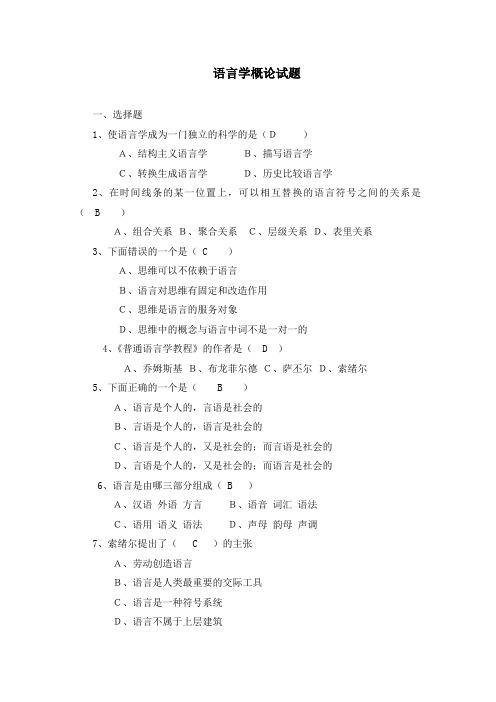
语言学概论试题一、选择题••••••1、使语言学成为一门独立的科学的是(D)A、结构主义语言学B、描写语言学C、转换生成语言学D、历史比较语言学2、在时间线条的某一位置上,可以相互替换的语言符号之间的关系是( B )••••A、组合关系B、聚合关系C、层级关系D、表里关系3、下面错误的一个是( C )•••••A、思维可以不依赖于语言•••••B、语言对思维有固定和改造作用•••••C、思维是语言的服务对象•••••D、思维中的概念与语言中词不是一对一的• 4、《普通语言学教程》的作者是( D )• A、乔姆斯基B、布龙菲尔德C、萨丕尔D、索绪尔5、下面正确的一个是( B )A、语言是个人的,言语是社会的B、言语是个人的,语言是社会的• C、语言是个人的,又是社会的;而言语是社会的• D、言语是个人的,又是社会的;而语言是社会的•6、语言是由哪三部分组成( B )• A、汉语外语方言B、语音词汇语法• C、语用语义语法D、声母韵母声调7、索绪尔提出了( C )的主张A、劳动创造语言B、语言是人类最重要的交际工具C、语言是一种符号系统D、语言不属于上层建筑8、下列材料,属于组合关系的是( B )A、b p m f B、不足改革•• C、a h o t D、哈额击妈•9、汉语中的轻声是利用( C )构成的• A、音高B、音长• C、音强D、音质10、决定音高的是声音的( C )A、振幅B、陪音•••••C、频率D、声波复合的形式11、一种语言中数量最少的是( B )••A、音素B、音位••C、语素D、音节12、普通话的“好”,用国际音标记为( B )••••••A、〔hao〕B、〔xau〕C、〔hau〕D、〔xao〕•13、发音的时候。
声带振动,发音部位之间形成的窄缝比较大,气流略有摩擦。
这样发出的音叫( B )•••••A、元音B、半元音C、浊擦音D、塞擦音•14、〔d〕和〔t〕两个音素( A )• A、在英语里是不同的音位,在汉语里是同一个音位• B、在汉语里是不同的音位,在英语里是同一个音位• C、在汉语、英语里都是不同的音位• D、在汉语、英语里都是同一个音位•15、可以归并在同一个音位中的音素是( A )•• A、具有互补关系、语音上又相似的音素•• B、语音上相似的音素•• C、彼此能区分词的语音形式和意义的音素•• D、具有非对立性关系的音素•二、试以国际音标标出下列各词的读音1、大学2、、明白3、自己4、开会5、离开三、简答题1、指出汉语普通话 e音位的几个条件变体,•描述其发音特点和出现条件。
“语言学概论”(国家级精品课程)考试题库

“语言学概论”(国家级精品课程)考试题库一、填空题填空题:绪论部分1.我国古代学者为读懂古书而建立的训诂学、文字学、音韵学组成了我国的(),通称为“小学”。
2.“语言学概论”课程内容在语言学学科分类中,属于()语言学。
3.狭义的应用语言学一般是指()。
4.17世纪,法国波瓦雅的修道院里有两位学者阿尔诺.兰斯洛合编了一本()。
5.()语言学的出现,•标志着语言学走出传统语文学,成为一门独立的科学。
6.传统语文学一般主要指古代()、古代()和古代中国三个地方的语文学。
中国传统的语文学通常叫()。
7.语言系统的两种基本关系是()和()。
它们是打开语言的两把钥匙。
8.1786年,英国的()在皇家亚洲学会宣读的论文《三周年演说》中指出有共同的结构特点。
为了纪念这一新发现,这一年被认为是()诞生的一年。
9.历史比较语言学的奠基人是丹麦的()、德国的()和格里木。
10.语言的分类一般从两个方面进行:第一,按照语言的()特点分类;第二,按照语言的()关系分类。
11.著名语言学家瑞士的()的著作()标志着结构主义语言学的诞生。
12.美国结构主义语言学的代表人物是(),•他的代表著作是《语言论》。
13.转换生成语言学的代表人物是(),•他被称为“标准理论”的著作是《句法理论问题》。
14.根据语言的结构或者形态特点,一般把语言分为()、()、()和()四种。
参考答案:1.语文学2.理论3.语言教学4.普遍唯理语法5.历史比较6.印度.希腊.小学7.组合关系;聚合关系8.威廉琼斯;历史比较语言学9.拉斯克;葆朴10.结构(形态);亲属(来源)11.索绪尔;《普通语言学教程》11.布龙菲尔德12.乔姆斯基13.孤立语(词根语);粘着语;屈折语;多式综合语(编插语)填空题:语音学部分1.语音可以从()角度分析它的产生方式,从()角度分析它的表现形式(传递过程),从()角度分析它的功能作用。
2.从产生声音角度来看引起音质的不同主要是()、()和()三个方面。
语言学考试题
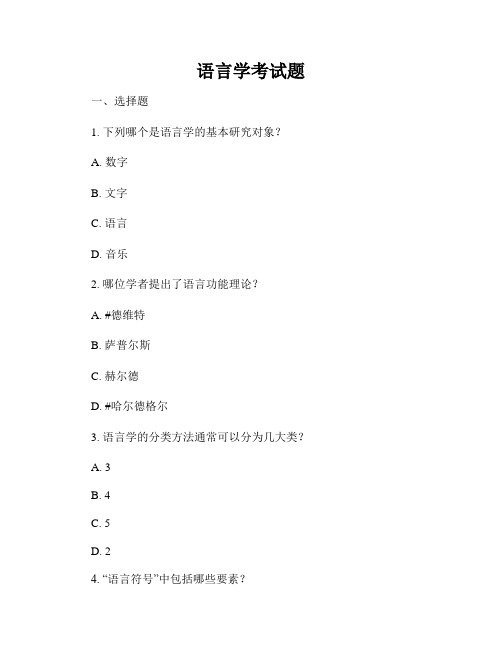
语言学考试题一、选择题1. 下列哪个是语言学的基本研究对象?A. 数字B. 文字C. 语言D. 音乐2. 哪位学者提出了语言功能理论?A. #德维特B. 萨普尔斯C. 赫尔德D. #哈尔德格尔3. 语言学的分类方法通常可以分为几大类?A. 3B. 4C. 5D. 24. “语言符号”中包括哪些要素?A. 声音B. 符号C. 拼写D. A、B5. 在语法范畴中,“动宾关系”是指什么?A. 主语和谓语之间的语法关系B. 主语和宾语之间的语法关系C. 宾语和谓语之间的语法关系D. 主语和动词之间的语法关系二、填空题6. 语言学中研究音素的学科是---。
7. 没有逻辑意义的音节称为---。
8. 语音学的基本单位是---。
9. 下列哪个不是语言学的分支学科?10. 一种语言中声母、韵母和声调三者综合的组合称为---。
三、简答题11. 请简要说明音韵学和语音学的区别。
12. 什么是“方言”,方言和语言的关系是什么?13. 什么是语法,语法的作用是什么?14. “文字和语言的关系”是语言学中一个重要问题,请简述你对这个问题的理解。
15. 请简要介绍语言学的研究方法有哪些?四、论述题16. 语言是人类最重要的交流工具之一,请说明语言对个体和社会的重要性。
17. 语言学的发展历程是怎样的?过去、现在和未来的语言学会有怎样的发展趋势?18. 请解释语言与文化之间的关系,并谈谈语言多样性对世界文化的重要影响。
以上便是本次语言学考试题的全部内容,请同学们认真地完成每一道题目,祝大家取得优异的成绩!。
语言学概论题库参考答案
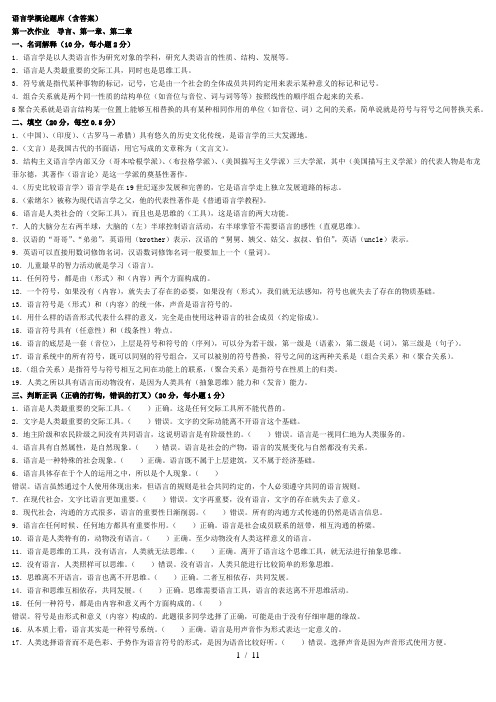
语言学概论题库(含答案)第一次作业导言、第一章、第二章一、名词解释(10分,每小题2分)1.语言学是以人类语言作为研究对象的学科,研究人类语言的性质、结构、发展等。
2.语言是人类最重要的交际工具,同时也是思维工具。
3.符号就是指代某种事物的标记,记号,它是由一个社会的全体成员共同约定用来表示某种意义的标记和记号。
4.组合关系就是两个同一性质的结构单位(如音位与音位、词与词等等)按照线性的顺序组合起来的关系。
5聚合关系就是语言结构某一位置上能够互相替换的具有某种相同作用的单位(如音位、词)之间的关系,简单说就是符号与符号之间替换关系。
二、填空(20分,每空0.5分)1.(中国)、(印度)、(古罗马-希腊)具有悠久的历史文化传统,是语言学的三大发源地。
2.(文言)是我国古代的书面语,用它写成的文章称为(文言文)。
3.结构主义语言学内部又分(哥本哈根学派)、(布拉格学派)、(美国描写主义学派)三大学派,其中(美国描写主义学派)的代表人物是布龙菲尔德,其著作(语言论)是这一学派的奠基性著作。
4.(历史比较语言学)语言学是在19世纪逐步发展和完善的,它是语言学走上独立发展道路的标志。
5.(索绪尔)被称为现代语言学之父,他的代表性著作是《普通语言学教程》。
6.语言是人类社会的(交际工具),而且也是思维的(工具),这是语言的两大功能。
7.人的大脑分左右两半球,大脑的(左)半球控制语言活动,右半球掌管不需要语言的感性(直观思维)。
8.汉语的“哥哥”、“弟弟”,英语用(brother)表示,汉语的“舅舅、姨父、姑父、叔叔、伯伯”,英语(uncle)表示。
9.英语可以直接用数词修饰名词,汉语数词修饰名词一般要加上一个(量词)。
10.儿童最早的智力活动就是学习(语言)。
11.任何符号,都是由(形式)和(内容)两个方面构成的。
12.一个符号,如果没有(内容),就失去了存在的必要,如果没有(形式),我们就无法感知,符号也就失去了存在的物质基础。
语言学:语言学概论考试题(题库版)
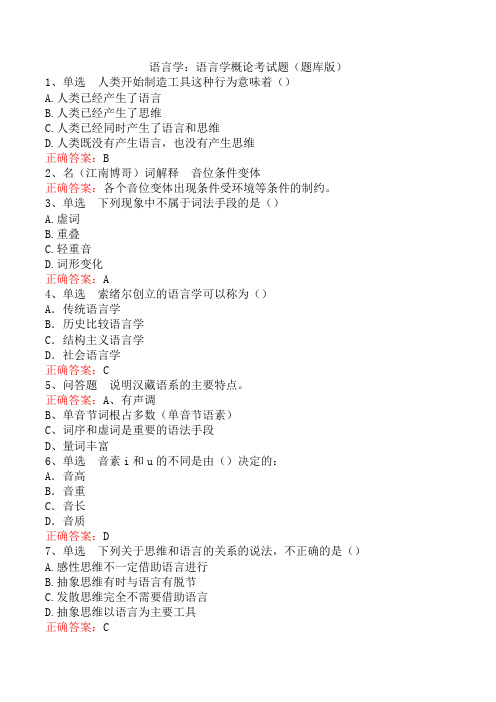
语言学:语言学概论考试题(题库版)1、单选人类开始制造工具这种行为意味着()A.人类已经产生了语言B.人类已经产生了思维C.人类已经同时产生了语言和思维D.人类既没有产生语言,也没有产生思维正确答案:B2、名(江南博哥)词解释音位条件变体正确答案:各个音位变体出现条件受环境等条件的制约。
3、单选下列现象中不属于词法手段的是()A.虚词B.重叠C.轻重音D.词形变化正确答案:A4、单选索绪尔创立的语言学可以称为()A.传统语言学B.历史比较语言学C.结构主义语言学D.社会语言学正确答案:C5、问答题说明汉藏语系的主要特点。
正确答案:A、有声调B、单音节词根占多数(单音节语素)C、词序和虚词是重要的语法手段D、量词丰富6、单选音素i和u的不同是由()决定的:A.音高B.音重C.音长D.音质正确答案:D7、单选下列关于思维和语言的关系的说法,不正确的是()A.感性思维不一定借助语言进行B.抽象思维有时与语言有脱节C.发散思维完全不需要借助语言D.抽象思维以语言为主要工具正确答案:C8、问答题论述语言学发展的历程?正确答案:语言学的发展同其他学科一样,经历了三个阶段:先是进行初步观察和内省思辩,然后是分清对象并加深观察和描写,最后才找出规律并形成理论体系。
从16世纪到18世纪,由于国际贸易的发展,西方国家的一些学者对外部世界的视野大大开阔了,懂得的语言和了解到的语言也大大增多了。
17世纪和18世纪不少人对各种不同语言的词语发生兴趣,纷纷搜集和编纂多语种的对照词表。
这时候有人发现欧洲和亚洲的有些语言之间有很多明显的相似之处,就开始加以比较研究,随后越来越多的人对欧洲和亚洲的一些语言进行比较研究。
最初的研究可以说直觉和猜想多于科学成分。
后来语言学吸取了控竽学和声学研究的成果,建立了科学的语音学,运用科学语音学的理论和方法逐步发现这些语言相互之间有严格的语音对应关系,而每一种语言本身自古以来的语音演变也有严格的语音演变规律,从而证明这些语言来源于相同的原始母语。
语言学概论试题库
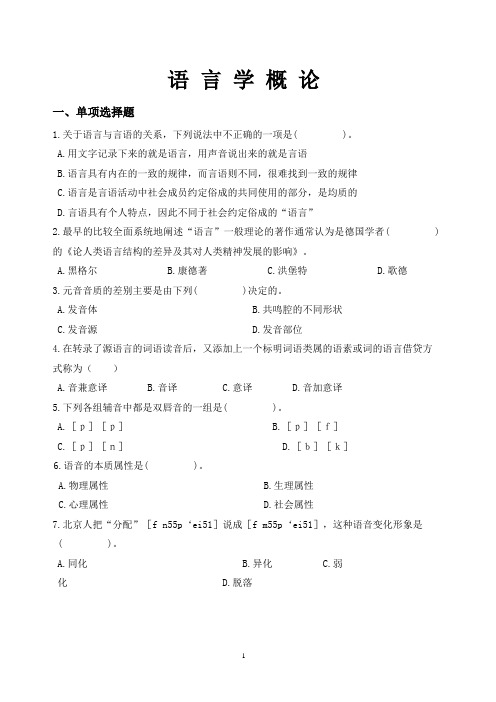
语言学概论一、单项选择题1.关于语言与言语的关系,下列说法中不正确的一项是( )。
A.用文字记录下来的就是语言,用声音说出来的就是言语B.语言具有内在的一致的规律,而言语则不同,很难找到一致的规律C.语言是言语活动中社会成员约定俗成的共同使用的部分,是均质的D.言语具有个人特点,因此不同于社会约定俗成的“语言”2.最早的比较全面系统地阐述“语言”一般理论的著作通常认为是德国学者( )的《论人类语言结构的差异及其对人类精神发展的影响》。
A.黑格尔B.康德著C.洪堡特D.歌德3.元音音质的差别主要是由下列( )决定的。
A.发音体B.共鸣腔的不同形状C.发音源D.发音部位4.在转录了源语言的词语读音后,又添加上一个标明词语类属的语素或词的语言借贷方式称为()A.音兼意译B.音译C.意译D.音加意译5.下列各组辅音中都是双唇音的一组是( )。
A.[p][p]B.[p][f]C.[p][n]D.[b][k]6.语音的本质属性是( )。
A.物理属性B.生理属性C.心理属性D.社会属性7.北京人把“分配”[f n55p‘ei51]说成[f m55p‘ei51],这种语音变化形象是( )。
A.同化B.异化C.弱化 D.脱落8.下列四组合成词中,()含有不成词语素。
A.火车B.热爱C.心疼 D.端详9.下列说法只有()是正确的。
A.哥本哈根学派是结构主义语言学的三大学派之一B.哥本哈根学派是转换----生存语言学的三大学派之一C.哥本哈根学派是社会语言学的三大学派之一D.哥本哈根学派是美国描写语言学的三大学派之一10.下列说法只有()是正确的。
A.汉字与汉语音节互相之间是完全对应的B.汉字记录音节但与音节并不完全对应C.从汉字与音节的联系看,汉字是音节文字D.汉字表示音节,不能适应汉语的特点11.目前世界上最通行的语言是()。
A.汉语B.英语C.阿拉伯语D.俄语12.下列说法只有()是正确的。
A.意译词都是借词B.仿译词都是借词C.“爱神”、“北极熊”、“超人”都是借词D.“尼姑”、“和尚”、“玻璃”是借词13. “天子”、“驸马”、“丞相”等词语在现代汉语中已经不再使用,这种变化是()A.词义的消亡B.词语的替换C.词义的演变D.词语的消亡14.中国的语言研究真正从语文学走向语言学的标志著作是()A.《方言》B.《马氏文通》C.《切韵》D.《经传释词》15.19世纪70年代的哲学家诺埃利提出的语言起源学说是()A.劳动叫感说B.手势说C.社会契约说D.摹声说16.利用阿拉伯数字编成码组代替文字符号的符号系统被称为()A.电报码B.手语C.盲文D.电脑码17.当儿童开始少量使用关联词语和修饰语时,就进入语言学习过程中的()A.独词句阶段B.双词句阶段C.电报句阶段D.复杂句阶段18.下列说法只有()不正确。
《语言学概论》练习题库参考答案
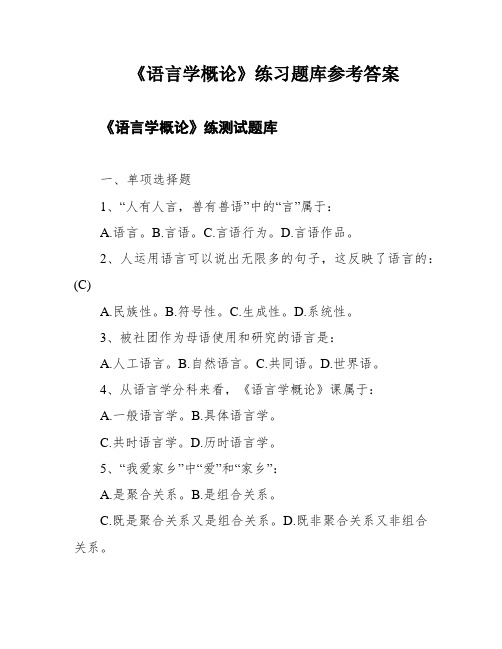
《语言学概论》练习题库参考答案《语言学概论》练测试题库一、单项选择题1、“人有人言,兽有兽语”中的“言”属于:A.语言。
B.言语。
C.言语行为。
D.言语作品。
2、人运用语言可以说出无限多的句子,这反映了语言的:(C)A.民族性。
B.符号性。
C.生成性。
D.系统性。
3、被社团作为母语使用和研究的语言是:A.人工语言。
B.自然语言。
C.共同语。
D.世界语。
4、从语言学分科来看,《语言学概论》课属于:A.一般语言学。
B.具体语言学。
C.共时语言学。
D.历时语言学。
5、“我爱家乡”中“爱”和“家乡”:A.是聚合关系。
B.是组合关系。
C.既是聚合关系又是组合关系。
D.既非聚合关系又非组合关系。
6、汉语南方方言比北方方言更接近于古汉语,这反映了语言发展的:A.渐变性。
B.相关性。
C.纪律性。
D.不均衡性。
7、下列说法正确的是:A.义项是最小的语义单位。
B.义素是最小的语义单位。
C.词义的主要内容是语法意义。
D.词义不包括语法意义。
8、有人说语言是古代文化的“活化石”,这说明语言具有:A.社交功能。
B.思维功能。
C.文化录传功能。
D.认知功能。
9、“衣领”是“衣服”的:A.上义词。
B.下义词。
C.总义词。
D.分义词。
10、转换生成语言学的代表人物是:A.XXX。
B.XXX。
C.XXX。
D.XXX。
11、下列说法正确的是A.语言是无限的,言语是有限的。
B.语言是个人的,言语是社会的。
C.语言是一般的,言语是个别的。
D.语言是具体的,言语是抽象的。
12、人类最重要的交际工具是A.文字。
B.语言。
C.书面语。
D.手势语。
13、下列说法正确的是A.所有的符号都有任意性。
B.有些符号有任意性。
C.只有语言符号有任意性。
D.语言符号没有任意性。
14、辞汇变革比语音语法快,这体现了语言开展的A.渐变性。
B.安定性。
C.相关性。
D.不均衡性。
15、“小王喜欢XXX”中“喜欢”和“XXX”A.是组合关系。
B.是聚合关系。
C.既是聚合干系又是组合干系。
语言学全部习题

语言学全部习题1. 简答题(每题10分,共30分)1) 什么是语言学?语言学是研究语言的科学,包括语音学、词法学、句法学、语义学、语用学等不同的分支。
它关注语言的结构、用法、演变以及和思维、社会和文化之间的关系。
2) 语言的基本要素包括哪些?语言的基本要素包括语音、词汇、句法、语义和语用。
语音研究发音和音系,词汇研究词的形态和词义,句法研究语言的句子结构,语义研究词和句的含义,语用研究语言的使用和交际。
3) 语音学和音系学有何区别?语音学研究语言中的语音现象,包括语音的产生、传播和感知等方面。
音系学研究语言中的音素系统,即语言中所有可能出现的音位和它们的组合规则。
2. 选择题(每题10分,共40分)1) 下列哪个不属于语言的基本要素?A. 语音B. 词汇C. 句法D. 语文答案:D2) 以下哪个学科不是语言学的分支?A. 语音学B. 语用学C. 数学D. 词法学答案:C3) 语音学主要研究哪方面的内容?A. 词义B. 词形C. 词语的使用D. 语音的产生和感知答案:D4) 以下哪个不是语言学的研究对象?A. 词汇表B. 句子结构C. 语言和思维的关系D. 社会语言规范答案:A3. 简答题(每题10分,共30分)1) 什么是语言的演变?语言的演变是指语言在使用过程中,由于多种因素的影响,其语音、词汇、句法等方面发生变化和发展。
语言的演变是一个长期的、渐进的过程,涉及到语言交流者的语言习惯、语音产生的方式、语法规则的改变等方面的变化。
2) 语言和思维之间有何关系?语言和思维之间有密切的关系。
一方面,语言是人类思维的表达工具,通过语言的运用,人们能够将思维中的概念、情感和意图等传递给他人。
另一方面,语言也影响思维的方式和内容。
语言结构和词汇的差异会影响人们的思维方式,不同语言对概念的划分和认知方式可能会有所不同。
3) 什么是语言交际?语言交际指的是人们通过语言进行沟通和交流的过程。
语言交际包括语言的使用、理解和解释,以及交流中的非语言行为和语境等因素。
语言学概论题库

语言学概论题库一、填空题1.理论语言学以研究对象的不同,又可分为()和()。
2.人类对语言的研究大体上可分为()阶段、()阶段、()阶段、()阶段、()阶段。
3.语言学概论课是()的入门课。
4.()、()、()具有悠久的历史文化传统,是语言学的三大发源地。
5.中国传统的“小学”是指()、()、()。
6.()是我国古代的书面语,用它写成的文章称为()。
7.()被称为现代语言学之父,其代表作(《普通语言学教程》)在语言学史上具有十分重要的地位。
8.以某一种具体语言为研究对象的语言学叫()。
9.()的建立,使语言学摆脱了过去的附庸地位,成为一门独立发展的科学。
10.从一个横断面描写研究语言在一个时期的状态的语言学就是()。
11.语言学的主要任务是研究语言的()和()。
12.语言研究有悠久的历史,是一门古老的学科,人们一般称之为()。
该时期的语言研究是以()为主要研究对象的。
13.运用语言传递信息的过程,可以分为()、()、()、()、解码五个阶段。
14.历史比较语言学的先驱人物是();草创者是();奠基人物是拉斯克、葆朴、格林。
15.()不但宣告语言学的真正独立、而且为普通语言学的研究奠定了基础。
16.普通语言学的奠基人物是()和()。
(《》)在语言学发展史上起到了划时代的作用。
17.结构主义语言学派可以分为三派,它们是(布拉格学派)、(哥本哈根学派)、(美国学派)。
18.形式语言学的主要代表人物是(),他认为对语言进行描写和分析的目的在于研究人的()能力。
他的目标是建立一个能产生所有句子的()。
19.新时期语言学的最大特点是()、()。
20.人和动物的区别是人会制造生产工具进行劳动,而且人来有(),这是人和动物相区别的重要标志之一。
21.一种语言中句子数量是无限的,人类之所以能掌握语言,是因为构成句子的语言材料和()是十分有限的。
22.语言是人类社会的(),而且也是思维的(),这是语言的两大功能。
23.人的大脑分左右两半球,大脑的()半球控制语言活动,右半球掌管不需要语言的感性直观思维。
语言学概论题库及答案

语言学概论题库及答案例题分析一一、填空1、()、()、()具有悠久的历史文化传统,是语言学的三大发源地。
2、19世纪占欧洲语言学统治地位的(),标志着语言学成为独立学科。
3、符号具有物质性与(),表意性与()。
4、语言符号具有线条性与()。
5、人类发音器官可以分为三大部分:()器官、()器官和咽腔、()、()等共鸣器。
6、人类语言中的元音,绝大多数都是()元音。
二、判别正误()1、对语言发展某一个时间平面的研究,称为状态研究,也称历时研究。
()2、标志着语言学进入现代语言学阶段的是历史比较语言学的兴起。
()3、语言是思维的唯一工具,所有思维活动都有语言参与。
()4、对个人来说,学话的过程实际上就是认识世界的过程,思维发展的过程。
()5、拼音文字用字母表音,都是按照“一个音对应一个字母,一个字母对应一个音”的原则。
()6、元音和辅音的最大区别是发音时声带是否振动。
三、单项选择1、下列各种情况,()不是符号。
A、红灯表示禁止通行B、烽烟表示有敌来犯C、桂花开放表示金秋季节来临D、打“×”表示内容错误2、关于语言的基础研究,以下观点不正确的是()。
A、历史的研究领先于状态的研究B、口语领先于书面语C、规范应当服从于约定俗成四、名词解释1、符号的任意性和理据性2、聚合关系五、分析操作1、按题意填写国际音标:舌面前半高不圆唇元音:()舌尖前清不送气塞擦音()2、根据提供音标写出其成音条件[A]()[d]()六、问答1、怎样理解语言是一个层级装置?2、什么叫音素?元音和辅音有哪些区别?参考答案一、1、中国印度希腊-罗马2、历史比较语言学3、表意性理据性4、层次性5、呼吸发音口腔鼻腔6、舌面二、1、错,应为共时研究。
2、错,应为结构主义语言学3、错,有些思维活动不一定有语言符号参与。
4、对。
5、错,只有国际音标才能严格做到这一点。
6、错,应为发音时气流是否受阻。
三、1、C2、A四、1、任何符号都是形式和内容的统一体,其形式就是物质性,存在形式;其内容就是表意性,代表了什么样的他事物。
语言学能力测试题库与解析
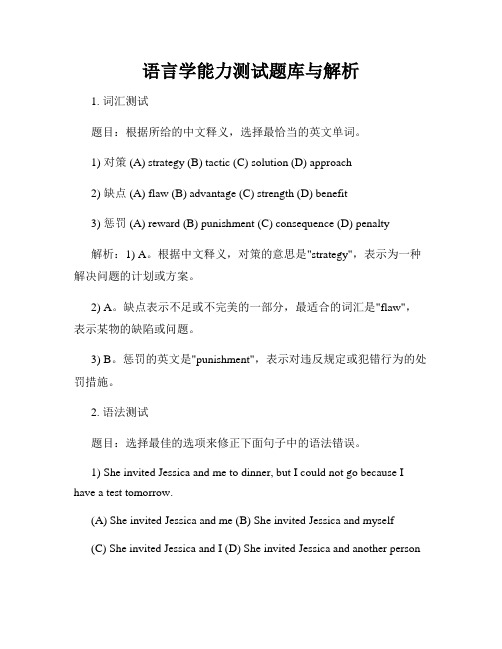
语言学能力测试题库与解析1. 词汇测试题目:根据所给的中文释义,选择最恰当的英文单词。
1) 对策 (A) strategy (B) tactic (C) solution (D) approach2) 缺点 (A) flaw (B) advantage (C) strength (D) benefit3) 惩罚 (A) reward (B) punishment (C) consequence (D) penalty解析:1) A。
根据中文释义,对策的意思是"strategy",表示为一种解决问题的计划或方案。
2) A。
缺点表示不足或不完美的一部分,最适合的词汇是"flaw",表示某物的缺陷或问题。
3) B。
惩罚的英文是"punishment",表示对违反规定或犯错行为的处罚措施。
2. 语法测试题目:选择最佳的选项来修正下面句子中的语法错误。
1) She invited Jessica and me to dinner, but I could not go because I have a test tomorrow.(A) She invited Jessica and me (B) She invited Jessica and myself(C) She invited Jessica and I (D) She invited Jessica and another person解析:A。
正确选项是"A",即"She invited Jessica and me to dinner",使用了正确的宾格代词"me"作为动词"invite"的宾语。
3. 句子改错题目:在下列句子中找出并改正语法错误。
1) There is many people in the park.解析:将"is"改为"are",即"There are many people in the park.",因为"people"是复数形式。
高名凯、石安石《语言学概论》章节题库(5-7章)【圣才出品】

第5章语法一、名词解释1.语法(北京师范大学2010年研)答:语法是词、短语、句子等语言单位的结构规律,即说话所遵守的词句排列组合的规矩。
它有两个含义,一是指语法结构规律本身,即平常说的语法事实;二是指语法学,即研究、描写、解释语法结构规律的科学,是对客观存在着的语法系统的认识和说明。
语法具有抽象性、生成性、层次性、递归性、系统性和稳固性等特征,一般包括词法和句法:词法是指词的构成和变化的规则;句法是指词或词组组成句子的规则。
2.语素(首都师范大学2011年研)答:语素是语言中音义结合的最小单位,是不能独立运用的构词语素。
语素可以根据不同的角度划分出不同的类型。
根据语音的数量可以划分为单音节语素和多音节语素。
如“马”是单音节语素,“葡萄”和“歇斯底里”是多音节语素。
根据语素在词中的不同作用把它分为词根和词缀,如“石头”中“石”是词根,“头”是词缀。
3.构词语素和构形语素(武汉大学2011年研)答:(1)构形语素构形语素指的是指在构词中只负责起改变词的形态,不改变词的意义,也不生成新的词的构词语素。
根据语素在词中的不同作用,把词根和派生词缀称为构词语素,词根是词的核心部分,词的意义主要是由它体现出来的。
它可以单独构成词,也可以彼此组合成词,也可以和词缀一起构成词。
派生词缀黏附在词根语素上构成新词,也即增加了新的词汇义内容或改变了词的类别归属。
如英语的work是个动词,表“工作”义,而加了派生词缀-er后的worker增加了表“……的人”的词义,词类也变成了名词。
(2)构词语素构词语素指的是在构词中生成新词的构词语素。
把屈折词缀称为变词(构形)语素。
屈折词缀只能改变一个词的形式,不能构成新词。
也即屈折词缀增加的是表示句法范畴的意义,并且总是不改变词的类别归属。
比如英语的book加上-s以后成为books,walk 加上-s、-ing、-ed之后而成为walks、walking、walked,复数s不仅与单个名词有关,还决定句子中与它搭配的动词要用复数形式,是句法范畴的表征。
- 1、下载文档前请自行甄别文档内容的完整性,平台不提供额外的编辑、内容补充、找答案等附加服务。
- 2、"仅部分预览"的文档,不可在线预览部分如存在完整性等问题,可反馈申请退款(可完整预览的文档不适用该条件!)。
- 3、如文档侵犯您的权益,请联系客服反馈,我们会尽快为您处理(人工客服工作时间:9:00-18:30)。
Exercise FiveI. DefinitionDirections: Define the following terms in English1. pragmatics2. syntax3. language acquisition4. morphology5. idiolectII Blank fillingDirections: Fill in each blank in the following statements.1. The different phones which can represent a phoneme in different phonetic environments are called the ________ of that phoneme.2. When pitch, stress and sound length are tied to the sentence rather than the word in isolation, they are collectively known as ________.3. The type of inversion operation involving the movement of a word from the head position in one phrase into the head position in another is known as ________.4. According to British linguist G. Leech, a predication consists of ________ and predicate.5. V ocabulary change can include: addition of new words, ________, and changes in the meaning of words.6. In some speech communities, two languages are used side by side with each having a different role to play, and language switching occurs when the situation changes. This constitutes the situation of ________.7. The study of sounds used in linguistic communication led to the establishment of ________.8. Krashen put forward that learners advance their language learning gradually by receiving ________, which he de fined as “i + l”.9. Generally four types of motivation have been identified: instrumental motivation, integrative motivation, resultative motivation, and ________ motivation.10. ________, an important theory in the pragmatic study of language, was originated with the British philosopher John Austin in the late 50‟s of the 20th century.III Multiple choiceDirections: There are four choices in each of the following statements. Choose the one that can best complete the statement.1. When we consider the variation relating to what a user is trying to do with language, we are dealing with addressee relationship—continually categorized as “______”.A. tenor of discourseB. mode of discourseC. field of discourseD. idiolect2. According to words‟ struc tures, Turkish is a typical ______ language.A. isolatingB. fusionalC. analyticD. agglutinative3. ______ refer to the fact that one type of utterance is typically followed by a special type of utterance.A. Minimal pairsB. Illocutionary actsC. Social dialectsD. Adjacency pairs4. The relation between “dead” and “alive” is labeled as ________.A. gradabilityB. complementarityC. hyponymyD. homonymy5. The words “encore” and “au pair ” are loanwords from _______.A. FrenchB. GermanC. ItalianD. Spanish6. The distinction of langue and parole is proposed by______.A. N. ChomskyB. F. de SaussureC. M. A. HallidayD. J. Austin7. Which of the following is the exception to the feature of arbitrariness of language?A. native English wordsB. borrowed wordsC. echoic wordsD. one-syllable words8. Which of the following feature cannot be used to describe the phone [s]?A. voicelessB. oralC. alveolarD. lateral9. In terms of place of articulation, the two consonants [f], [v] are ________.A. dentalB. alveolarC. palatalD. labiodental10. In terms of manner of articulation, the sounds [p], [b], [t], [d], [k], [g] are ________.A. affricatesB. fricativesC. bilabialD. oral stops11.The famous quotation from Shakespeare's play “Romeo and Juliet” …A rose by any other name would smell as sweet‟ well illustrates _______.A. the conventional nature of languageB. the creative nature of languageC. the universality of languageD. the big difference between human language and animal communication12.Of the following sound combinations, only _______ is permissible according to the sequential rules in English.A. kiblB. bkilC. ilkbD. ilbk13.The sentence that has a NP and a VP can be shown in a _______ formula "S→NP VP".A. hierarchicalB. linearC. tree diagramD. vertical14.It is the _______ on Case assignment that states that a Case assignor and a Case recipient should stay adjacent to each other.A. Case ConditionB. parameterC. Adjacent ConditionD. Adjacent Parameter15.Predication analysis is a way to analyze _______ meaning.A. phonemeB. wordC. phraseD. sentence16.According to Searle, those illocutionary acts whose point is to commit the speaker to some future course of action are called _______.A. commisivesB. directivesC. expressivesD. declaratives17.The term _______ linguistics may be defined as a way of referring to the approach which studies language change over various periods of time and at various historical stages.A. synchronicB. diachronicC. comparativeD. historical comparative18.The way in which people address each other depends on their age, sex, social group, and personal relationship. The English system of address forms frequently used includes first name, last name, title +last name, _______,and kin term.A. title+first nameB. title+titleC. title aloneD. first name+last name+titlenguage and thought may be viewed as two independent circles overlapping in some parts. When language and thought are identical or closely parallel to each other, we may regard thought as "subvocal speech," and speech as "_______".A. vocal thoughtB. subvocal thoughtC .covert thought D. overt thought20. Which of the following best states the behaviorist view of child language acquisition?_______.A. Language acquisition is a process of habit formationB. Language acquisition is the species-specific property of human beingsC. Children are born with an innate ability to acquire languageD. Humans are equipped with the neural prerequisites for language and language useIV True of FalseDirections: Decide whether the following statements are true or false. Write T for true and F for false.1. A sentence cannot be a word or a fragment in strict sense, but an utterance can be a word or a fragment of a sentence.2. It doesn‟t make sense to ask what l anguage a sentence belongs to.3. A stem first of all refers to any morpheme or combination of morphemes, but an affix can be added to it.4. Every word in a language can find at least one referent in the objective world.5. In most cases, lexicon means vocabulary and is related to the analysis and creation of words, idioms and collocations.6. Compounding is the formation of new words by joining two or more stems.7. Metathesis refers to the change of a sound as a result of the influence of an adjacent sound.8. The requirement that the forms of two or more words of specific word classes which stand in specific syntactic relationship with one another shall also be characterized by the same paradigmatically marked category or categories is called concord.9. According to Searle, those illocutionary acts whose point is to commit the speaker to some future course of action are called directives10. The term synchronic linguistics may be defined as a way of referring to the approach which studies language change over various periods of time and at various historical stages.。
